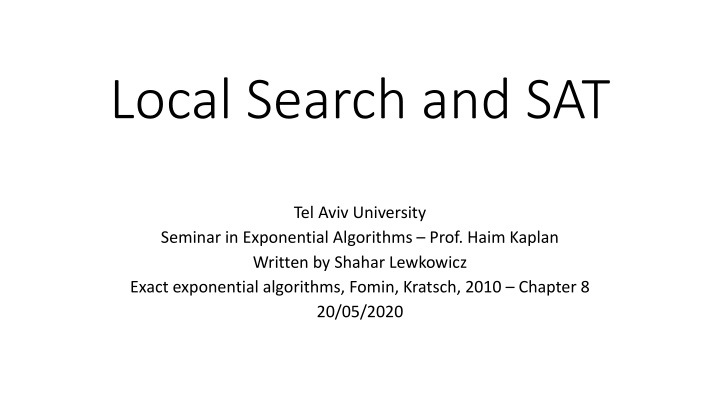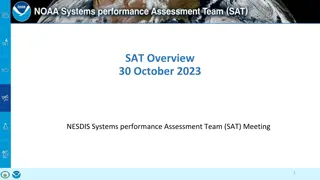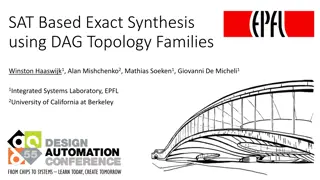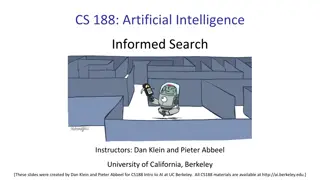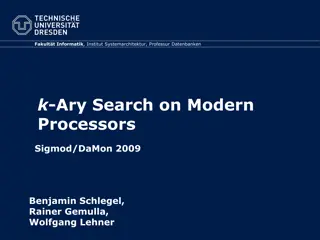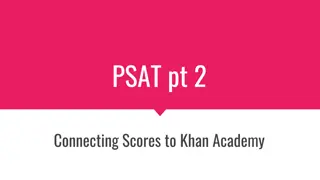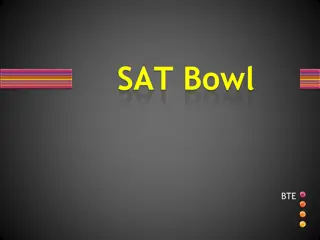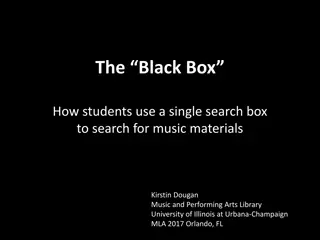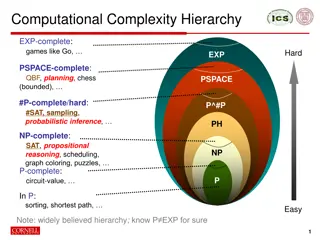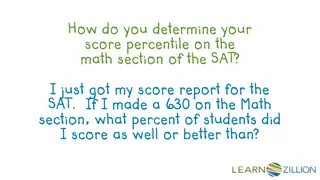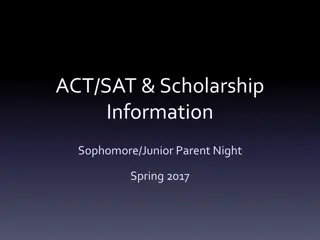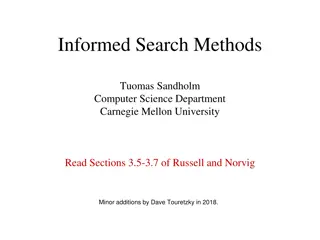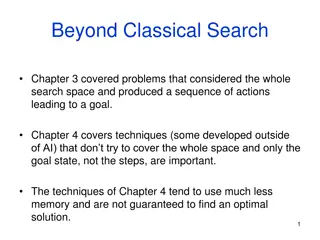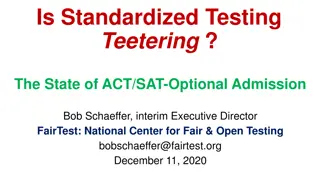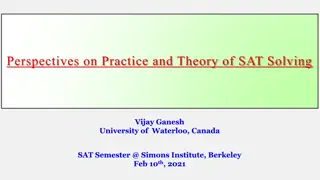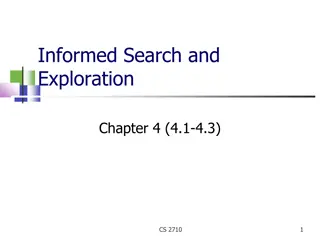Local Search and SAT Tel Aviv University Seminar
A seminar on Local Search and SAT at Tel Aviv University focusing on Exponential Algorithms, led by Prof. Haim Kaplan and written by Shahar Lewkowicz. The seminar delves into exact exponential algorithms and Boolean variables, assignments, disjunction formulas, K-SAT problems, formula examples, assignments, n-bit strings, and Hamming distance definitions, along with examples and facts.
Download Presentation

Please find below an Image/Link to download the presentation.
The content on the website is provided AS IS for your information and personal use only. It may not be sold, licensed, or shared on other websites without obtaining consent from the author.If you encounter any issues during the download, it is possible that the publisher has removed the file from their server.
You are allowed to download the files provided on this website for personal or commercial use, subject to the condition that they are used lawfully. All files are the property of their respective owners.
The content on the website is provided AS IS for your information and personal use only. It may not be sold, licensed, or shared on other websites without obtaining consent from the author.
E N D
Presentation Transcript
Local Search and SAT Tel Aviv University Seminar in Exponential Algorithms Prof. Haim Kaplan Written by Shahar Lewkowicz Exact exponential algorithms, Fomin, Kratsch, 2010 Chapter 8 20/05/2020
Boolean variables and assignments n Boolean variables A literal is a variable or the negation of a variable. There are 2n literals: A truth assignment (i.e. assignment) is a rule which map each of the variables to a Boolean value (0 or 1). An example of an assignment (when n=4):
Boolean disjunction formulas A disjunction clause (i.e. clause) of k variables: where for each , is a literal. Example (when k=4, assuming n>=100): An assignment satisfies a clause if there exists at least one such that the literal is 1 according to the assignment. For example, the assignment satisfies the above clause; the assignment that gives all variables 0 except the variables (which are given the value 1) does not satisfy the close.
K-SAT We are given n variables We are given m clauses (i.e. a formula) Each clause contains exactly k literals (why this restriction?...) In the decision problem, we ask whether there is at least one assignment that satisfies ALL the clauses (the formula), or not. Sometimes, we also wish to find an assignment that satisfies all the clauses, if there exists one. The latter problem is not easier than the previous. In this class all the algorithms we will talk about solve the latter problem.
A Formula Example n=4, m=5, k=3 (3-SAT) Satisfying assignment: Non satisfying assignment:
Assignments and n-Bit Strings We can declare a function that maps each assignment to the n-bit string This function is a bijection, so we can also speak about it s inverse function. a
Hamming Distance - Definition Given two n bit strings we define the hamming distance between them: g Given two assignments on n variables b and c we define the hamming distance between them to be the hamming distance between their two representatives n-bit strings.
Hamming Distance Example and Facts For example: the hamming distance between these two assignments: is the hamming distance between these two bit strings: which is 2. It can be seen that:
Balls - Definition Given an assignment a and an integer r, we define: It can be seen that Note that the size above is not dependent on the assignment a (i.e. The size of the ball is the same for all assignments).
Algorithms solving K-SAT It takes O(mk) time to check whether a given assignment satisfies a given formula (why?) Therefore - instead of analyzing the time of an algorithm we will analyze the number of the assignments that the algorithm checks.
The Nave Algorithm - Definition Input: a formula f. Output: Answer whether f is satisfiable or not; if it is also output an assignment that satisfies it. Algorithm: 1. For each possible assignment a: 1.1. Check if a satisfies f. If it is: 1.1.1. output a and conclude that f is satisfiable. 2. Conclude that f is not satisfiable.
The Nave Algorithm - Analyze If the formula is not satisfiable the time is always . If the formula is satisfiable by one assignment: The time in the worst case is The time in the average case (assuming ) is . This is huge! We want to reduce this time!
Geometric Distribution - Definition Let s assume we flip a coin which falls on 1 with probability (i.e. success) and falls on 0 with probability 1-p (i.e. failure). We repeat flipping the coin until we succeed (i.e. until coin falls on 1). Let N be the number of times we had to flip the coin (including the last flipping which succeeded). We will say that N is a geometric variable with the parameter p. It can be proven that
Markovs Inequality Let X be a non-negative random variable and let c>0. Then:
Random_Walk Algorithm - Definition 1. Choose a truth assignment a - uniformly at random. 2. count 0 3. while count <3n: 3.1. Choose an arbitrary clause which is not satisfied by a. 3.2. Choose one variable v of this clause - uniformly at random. 3.3. Flip v s value (in the assignment a). 3.4. if a is a satisfying assignment: 3.4.1. Output a and conclude that f is satisfiable. 3.5. count count + 1 4. Conclude that f is not satisfiable.
Random_Walk Algorithm - Analyzing Time in the worst case is 3n=O(n). If the formula is not satisfiable the algorithm will always be correct. If the formula is satisfiable what is the probability that the algorithm will be correct? We would like to find a lower bound Assuming the formula is satisfiable, let s find a lower bound on q the probability that the algorithm will be correct (in this case). There is at least one satisfying assignment a* of the formula. We need to find a lower bound on the probability that the algorithm will output a* (why?)
Random_Walk Algorithm Analyzing (2) At each step, the hamming distance from a* to a decreases by 1 (good move) with probability of at least 1/k and increased by 1 (bad move) with probability of at least (k-1)/k. (why?)
Random_Walk Algorithm Analyzing (3) In the following 2 slides, let s assume that we start from an assignment a which is at distance j from a*: We define the probability that the algorithm finds a* in j+2x steps: j+x steps are good moves and x steps are bad moves. is a conditional probability.
Random_Walk Algorithm Analyzing (4) Assuming we start from an assignment a which is at distance j from a*: Define the probability that the algorithm finds a* when starting from an assignment a which is at distance j from a*. is a conditional probability. In the right inequation, we choose and we cannot do better
Random_Walk Algorithm Analyzing (5) Let be the probability that we choose a to be at distance j from a* Let q be the probability that the algorithm successfully find a*.
Persistent_Walk Algorithm Assumption: the formula is satisfiable. The algorithm: run Random_Walk until it returns a satisfying assignment. The algorithm is always correct. The probability for infinite loop: 0. Let N be the number of times Random_Walk was called. The expected time of Persistent_Walk :
Persistent_Walk vs the Nave Algorithm Advantages of Persistent_Walk : Estimated time is much lower than Na ve Algorithm. We do not depend on the mercy of an evil opponent (why?) Advantages of Na ve Algorithm: No assumption that the formula is satisfiable. The actual running time is NEVER bigger than . .
Half_Monte_Carlo Algorithm - Definition 1. count 0 2. while : 2.1. Run Random_Walk() 2.2. if the above call concluded that f is satisfiable: 2.2.1. Output the printed assignment and conclude that f is satisfiable. 2.3. count count + 1 3. Conclude that f is not satisfiable.
Half_Monte_Carlo Algorithm - Analyzing The worst case time: If the formula is not satisfiable Half_Monte_Carlo will always be correct. If the formula is satisfiable - Half_Monte_Carlo will conclude that it is not with probability of at most 0.5. We will prove it now. Let N be the number of times Random_Walk should be called in order to find a satisfying assignment. As we have seen,
Half_Monte_Carlo Algorithm Analyzing (2) but error occurs when so from Markov (c=2) we get But what if we want to lower the error probability? If we run this scheme b times we will get an error probability of Credit to Schoning
What we have seen so far? We have seen an example of local search: using random walk. We have seen the Persistent_Walk algorithm: The assumption that the formula is satisfiable is required. The algorithm is always correct. The estimated running time is . We have seen the Half_Monte_Carlo algorithm: The algorithm has a one-sided error of . The running time in the worst case is the same as above:
Ball_Search - Definition Input: a formula f, a truth assignment a, a non-negative integer d. Output: Answer whether there exists a satisfiable assignment a* such that ; if there is also output such an assignment. Algorithm:
Ball_Search Algorithm - Definition (2) 1. Check if a satisfies f. If it is: 1.1. output a and return yes . 2. if d=0: 2.1. return no . 3. Choose an arbitrary clause which is not satisfied by a. 4. for each literal in that clause: 4.1. let b be the truth assignment a after flipping that literal. 4.2. run Ball_Search(f, b, d-1). 4.3. if the above call returned yes : 4.3.1. output the printed assignment and return yes . 5. return no .
Ball_Search Algorithm - Analyzing Correctness: It is easy to see that the algorithm is correct for d=0. If d>0, a is not a satisfying assignment and there is then a and a* differ in at least one variable chosen in line 3 (why?). If we understand that then it is easy to prove the correctness (using induction on d). Running time:
Random_Ball Algorithm: Ball_Search(f, a, ) where a is chosen uniformly at random and . If the formula is not satisfiable then the algorithm is correct. If the formula is satisfiable then there is a satisfying assignment a*. Therefore, We will choose
Persistent_Ball Same idea as in Persistent_Walk but instead of running Random_Walk we run Random_Ball. Analyze is similar: The expected number of calls to Persistent_Ball is so the expected running time is Note: we chose . That is not better than Persistent_Walk
Monta Carlo Algorithm for Random_Ball We can obtain a Monta Carlo algorithm with the same running time in a similar way like we did before That algorithm will not be good as the algorithm we saw before
Two_Front Algorithm The algorithm: run Ball_Search(f, , n/2) and Ball_Search(f, , n/2). Act according to the returned (and printed) value of these 2 calls
Two_Front Algorithm - Analyze Correctness: The algorithm is correct because for each possible assignment a: or . Running time: If k=3 (3-SAT) then the running time is . That is better than the na ve algorithm! What if k>3 ? That is worse than the na ve algorithm. Perhaps we should try to improve it by using balls of smaller sizes
Reminder: Dominating Set Dominating Set D in graph G=(V,E) is a subset of V such that for each : either or u has a neighbor w such that . In other words, for each there exists such that . 3 Examples:
Cover Code - Definition A cover code C of radius r (in ) is a subset of such that for each truth assignment there is such that . For example, is a code of radius 3 (why?) Dominating Set is a code cover of radius 1. Our target to make a deterministic version of Persistent_Ball without increasing the expected time using a code cover! How?
Reminder: Minimum Set Cover Universe U={1,2, ,u}. A collection of sets such that We need to find a subset of S with minimum number of sets (i.e. minimize q) such that for each there exists a set such that Greedy Algorithm: Always pick the set which covers the maximum number of uncovered elements, until all elements are covered. The Greedy Algorithm is log t-approximation
Reduction from Cover Code to Set Cover The universe U will be the possible assignments. The number of sets (i.e. t, the size of S) will also be - for each possible assignment a there will be a suitable set -
Back to Code Cover If C is a code cover of radius , then There exists a code C of radius such that Therefore, the Greedy Algorithm for Set Cover will output a cover code of radius such that the code s size will be
What is left to do? 1. Prove the claim: There exists a code C of radius such that 2. Speak about the running time of our algorithm to find the code cover. If it is too high we will want to find ways to reduce it
Probabilistic Proof We will choose uniformly at random assignments (with possible repetitions). We will show that the probability that C is a cover code of radius is bigger than zero which means such code exists (if there wasn t such a code the probability would have been zero). Let a be an assignment. For each : The probability that a is not covered by C is .
Probability Proof (2) The probability that C is not a cover code with radius is The probability that C is a cover code with radius is at least Therefore, there exists such a code.
Running Time of the Algorithm for Code Cover The number of selections is at most and for every selection a re- computation of covered assignments takes time . Therefore: For each a covering code C of radius of size of at most can be computed in time . Problem: But this is too much time! Can we improve it?
Improve the Running Time By partition the set of n variables into 6 groups of size n/6 and take care of each group separately. What will we do if n is not divided by 6? We will solve the problem for each of this 6 groups of variables in order to get 6 cover codes (each with radius ). Then we will try all the possible concatenations of codes in order to get the code that we want. The total running time in the worst case will be This is also the expected running time of Persistent_Ball!
Conclusion We have seen the basic idea of local search. We have seen 2 types of local search: random walk (random path) and ball search. Walking is better than balls in regarding the expected time. However, by ball search we can obtain deterministic algorithms which have estimated time that may not be good as the walking, but is still much better than the na ve algorithm.
